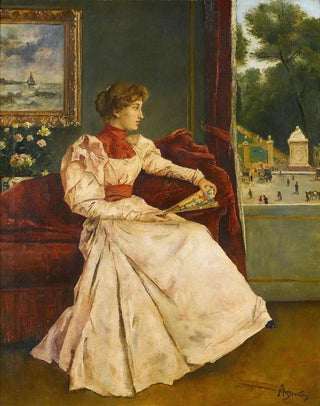Art print | At home - Alfred Stevens


View from behind

Frame (optional)
Chez soi - Alfred Stevens – Engaging Introduction
In the world of art, some artworks manage to capture such a profound essence of everyday life that they resonate with our own experience. "Chez soi," painted by Alfred Stevens, is one of these works. It transports us into a refined interior, revealing both the intimacy of a home and the beauty of the surrounding details. This painting, with its harmonious composition and delicate color palette, invites us to explore the subtleties of domestic life at the end of the 19th century. By contemplating this piece, we feel an immediate connection with the artist's universe, who manages to immortalize simple moments, yet charged with emotion.
Style and uniqueness of the artwork
Alfred Stevens' style is distinguished by his ability to blend realism and impressionism, creating a vibrant and lively atmosphere. In "Chez soi," he uses subtle touches of light to highlight the textures and reflections of objects within the scene. The interplay of shadow and light gives an almost tactile dimension to the work, making each element of the scene palpable. The characters, often elegantly dressed women, are depicted with finesse that emphasizes their grace and dignity. The scene depicts a moment of tranquility, where the viewer can almost hear the whisper of conversations and feel the warmth of the home. This attention to detail and capacity to evoke emotions make "Chez soi" a centerpiece, both intimate and universal.
The artist and his influence
Alfred Stevens, born in Brussels in 1823, was an artist whose career spanned several decades, marked by travels across Europe and collaborations with other great masters of his time. His work is often associated with the depiction of women in domestic settings, revealing both their strength and vulnerability. Stevens was able to draw inspiration from the artistic currents of his era, while developing a personal style that was uniquely his own. His influence is evident in the way he captured everyday life with rare sensitivity, paving the way for other artists who followed in his footsteps. Through his paintings, he contributed to redefining the place

Matte finish

View from behind

Frame (optional)
Chez soi - Alfred Stevens – Engaging Introduction
In the world of art, some artworks manage to capture such a profound essence of everyday life that they resonate with our own experience. "Chez soi," painted by Alfred Stevens, is one of these works. It transports us into a refined interior, revealing both the intimacy of a home and the beauty of the surrounding details. This painting, with its harmonious composition and delicate color palette, invites us to explore the subtleties of domestic life at the end of the 19th century. By contemplating this piece, we feel an immediate connection with the artist's universe, who manages to immortalize simple moments, yet charged with emotion.
Style and uniqueness of the artwork
Alfred Stevens' style is distinguished by his ability to blend realism and impressionism, creating a vibrant and lively atmosphere. In "Chez soi," he uses subtle touches of light to highlight the textures and reflections of objects within the scene. The interplay of shadow and light gives an almost tactile dimension to the work, making each element of the scene palpable. The characters, often elegantly dressed women, are depicted with finesse that emphasizes their grace and dignity. The scene depicts a moment of tranquility, where the viewer can almost hear the whisper of conversations and feel the warmth of the home. This attention to detail and capacity to evoke emotions make "Chez soi" a centerpiece, both intimate and universal.
The artist and his influence
Alfred Stevens, born in Brussels in 1823, was an artist whose career spanned several decades, marked by travels across Europe and collaborations with other great masters of his time. His work is often associated with the depiction of women in domestic settings, revealing both their strength and vulnerability. Stevens was able to draw inspiration from the artistic currents of his era, while developing a personal style that was uniquely his own. His influence is evident in the way he captured everyday life with rare sensitivity, paving the way for other artists who followed in his footsteps. Through his paintings, he contributed to redefining the place






